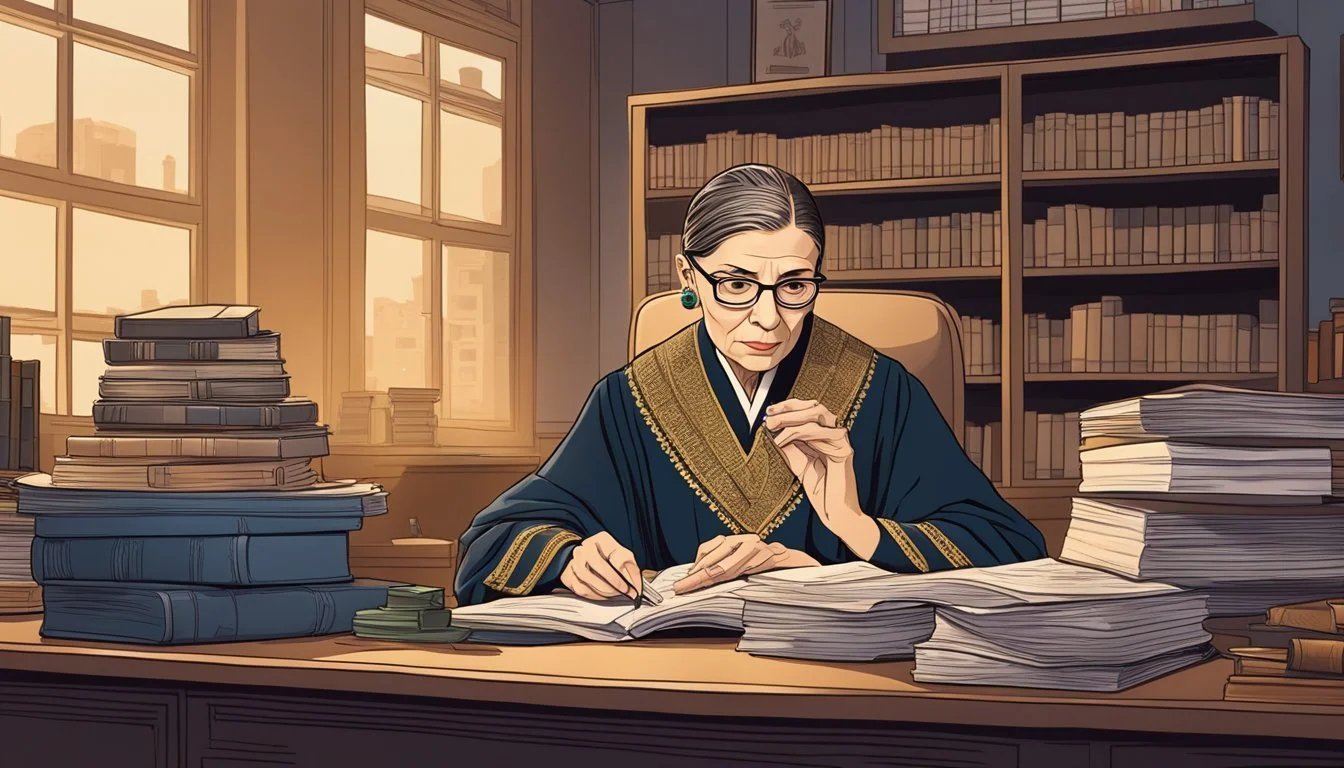Before the Bench: RBG's Early Struggles Portrayed in 'On the Basis of Sex'
A Young Ruth Bader Ginsburg's Legal Journey
Ruth Bader Ginsburg's journey to becoming a Supreme Court Justice was filled with challenges and triumphs. The film "On the Basis of Sex" sheds light on her early career as a lawyer, focusing on a pivotal case that would shape her legacy in the fight against gender discrimination.
The movie portrays Ginsburg's battle against deeply entrenched injustices that were considered part of the "natural order" at the time. It follows her as she argues her first sex-discrimination case in federal court, laying the groundwork for future legal victories. The film captures the persistence and determination that would become hallmarks of Ginsburg's approach to the law and social change.
"On the Basis of Sex" serves as both a legal procedural and an origin story for the woman who would become known as the Notorious RBG. It highlights the personal and professional obstacles Ginsburg faced in a male-dominated field, while also showcasing her brilliance and unwavering commitment to equality under the law.
Rise of a Legal Icon
Ruth Bader Ginsburg's journey to becoming a legal icon began with her early education and experiences. Her time at Harvard Law School presented significant challenges, which she overcame with determination. These formative years laid the groundwork for her groundbreaking legal career.
Early Life and Education
Ruth Bader Ginsburg was born in Brooklyn, New York in 1933. She excelled academically from a young age, graduating high school at 15. Ginsburg attended Cornell University on a scholarship, where she met her future husband Martin Ginsburg.
She graduated first in her class from Cornell in 1954 with a degree in government. This early academic success foreshadowed her future achievements in law.
Harvard Law School Challenges
In 1956, Ginsburg entered Harvard Law School as one of only nine women in a class of over 500. She faced significant discrimination and skepticism from faculty and peers.
The dean famously asked the female students to justify taking spots from qualified male candidates. Despite these obstacles, Ginsburg excelled academically. She became the first female member of the Harvard Law Review.
Ginsburg transferred to Columbia Law School for her final year when her husband took a job in New York City.
Legal Career Kickstart
After graduating from Columbia Law School in 1959, Ginsburg struggled to find employment despite her stellar academic record. Many law firms were unwilling to hire women at the time.
She eventually secured a clerkship with U.S. District Judge Edmund L. Palmieri through the recommendation of a Columbia professor. This position launched her legal career.
Ginsburg went on to teach at Rutgers Law School and Columbia Law School. She became known for her work on gender discrimination cases, laying the foundation for her future impact on women's rights.
Championing Gender Equality
Ruth Bader Ginsburg dedicated her career to advancing gender equality through legal action. Her strategic approach and landmark cases fundamentally reshaped the legal landscape for women's rights in the United States.
ACLU and Women's Rights Project
In 1972, Ginsburg co-founded the Women's Rights Project at the American Civil Liberties Union (ACLU). This initiative aimed to challenge sex discrimination systematically through carefully selected cases.
Ginsburg served as the project's first director, overseeing a team of lawyers who brought gender discrimination cases to court. Their goal was to establish legal precedents that would expand protections for women under the law.
The Women's Rights Project tackled issues like workplace discrimination, unequal pay, and restrictive policies that limited women's opportunities. Ginsburg argued six gender discrimination cases before the Supreme Court during this period, winning five.
Landmark Gender Discrimination Cases
Ginsburg's strategy involved highlighting how sex-based discrimination harmed both men and women. One notable case was Weinberger v. Wiesenfeld (1975), where she represented a widower denied Social Security benefits typically given to widows.
In Reed v. Reed (1971), Ginsburg successfully argued against an Idaho law that automatically preferred men over women as estate administrators. This marked the first time the Supreme Court struck down a law for gender discrimination.
Another significant victory came in Frontiero v. Richardson (1973), which challenged unequal treatment of women in the military. The case resulted in increased benefits for female service members and their families.
RBG's Personal Struggles and Triumphs
Ruth Bader Ginsburg faced numerous challenges in her personal and professional life. She navigated a demanding career while raising a family and supporting her husband through health issues.
Balancing Family and Career
Ruth Bader Ginsburg excelled in her legal career while raising two children. She often worked late into the night after her children were asleep.
Ginsburg relied on a strong support system, including her mother-in-law and household help. This allowed her to focus on her work and studies.
She strategically chose courses that aligned with her children's schedules while at Harvard Law School. Ginsburg's dedication to both family and career set an example for future generations of working mothers.
Martin Ginsburg's Support
Martin "Marty" Ginsburg played a crucial role in Ruth's success. He was a supportive partner who shared domestic responsibilities.
Marty, a successful tax lawyer, often cooked meals and cared for their children. He recognized Ruth's brilliance and encouraged her ambitions.
Their marriage was a true partnership. Marty's unwavering support allowed Ruth to pursue her legal career and eventually ascend to the Supreme Court.
Battling Health Issues
Ruth Bader Ginsburg faced significant health challenges throughout her life. She battled cancer five times, beginning with colorectal cancer in 1999.
Despite her illnesses, Ginsburg maintained a rigorous work schedule. She famously worked on court opinions from her hospital bed.
Ginsburg's determination during her health struggles inspired many. Her resilience in the face of adversity became a hallmark of her character and career.
Noteworthy Legal Battles and Precedents
Ruth Bader Ginsburg's legal career was marked by several landmark cases that challenged gender discrimination. These cases set important precedents for equality under the law.
Moritz v. Commissioner of Internal Revenue
In 1972, Ginsburg argued Moritz v. Commissioner before the Tenth Circuit Court of Appeals. This case involved Charles Moritz, a man denied a tax deduction for caring for his elderly mother. The deduction was only available to women, widowers, or divorced men.
Ginsburg argued this law discriminated on the basis of sex. The court agreed, marking the first time a federal court struck down a law for gender discrimination. This victory opened the door for challenging other discriminatory laws.
Weinberger v. Wiesenfeld
Ginsburg took on Weinberger v. Wiesenfeld in 1975. Stephen Wiesenfeld, a widower, was denied Social Security survivor benefits that were only available to widows.
Ginsburg argued this violated the Equal Protection Clause. The Supreme Court unanimously agreed, ruling that gender-based distinctions in the Social Security Act were unconstitutional. This case highlighted how gender discrimination could harm both men and women.
Virginia Military Institute Case
In 1996, Ginsburg wrote the majority opinion in United States v. Virginia. This case challenged the Virginia Military Institute's male-only admission policy.
Ginsburg argued that excluding women violated the Equal Protection Clause. The Court ruled 7-1 in favor of admitting women. This decision established that gender-based classifications must have an "exceedingly persuasive justification" to be constitutional.
The ruling opened doors for women in military education and strengthened protections against sex discrimination.
On the Basis of Sex: The Biopic
"On the Basis of Sex" brings Ruth Bader Ginsburg's early legal career to the big screen. The film portrays her struggles and triumphs as she challenges gender discrimination in the 1970s.
Casting and Performances
Felicity Jones takes on the role of Ruth Bader Ginsburg, capturing her determination and intellect. Jones' portrayal showcases Ginsburg's tenacity and commitment to equality.
Armie Hammer plays Martin Ginsburg, Ruth's supportive husband. Their on-screen chemistry reflects the couple's strong partnership.
The cast brings depth to key figures in Ginsburg's life, including her law professors and legal opponents. These performances help illustrate the challenges Ginsburg faced in a male-dominated field.
Filmmaking and Direction
Director Mimi Leder brings a polished look to the biopic. Her attention to period details creates an authentic 1970s atmosphere.
Leder's direction emphasizes the personal and professional obstacles Ginsburg encountered. She balances courtroom drama with intimate family moments.
The film's pacing keeps viewers engaged as it follows Ginsburg's journey from law student to groundbreaking attorney. Leder's visual style complements the script's focus on Ginsburg's legal arguments and strategy.
Cultural Impact and Reception
"On the Basis of Sex" introduces Ginsburg's early career to a wider audience. It highlights her role in advancing gender equality through the legal system.
The film received praise for its inspiring portrayal of Ginsburg's perseverance. Critics noted its accessible approach to complex legal concepts.
Some viewers appreciated the personal insights into Ginsburg's life, courtesy of screenwriter Daniel Stiepleman, her nephew. The biopic contributed to Ginsburg's pop culture status as the "Notorious RBG."
The Legacy of RBG
Ruth Bader Ginsburg's impact on American law and culture extended far beyond her tenure on the Supreme Court. Her tireless advocacy for gender equality and civil rights shaped legal precedents and inspired generations.
From Notorious RBG to Pop Culture Icon
Ruth Bader Ginsburg transformed into a cultural phenomenon late in her career. The "Notorious RBG" moniker, inspired by rapper Notorious B.I.G., catapulted her to celebrity status. Her image graced t-shirts, mugs, and even tattoos.
Books, films, and documentaries chronicled her life and work. The biopic "On the Basis of Sex" highlighted her early legal battles. Her workout routine became famous, inspiring exercise books and memes.
RBG's lace collars, or jabots, became a symbol of her judicial voice. She wore different collars to express her views on court decisions.
Influence on Women's Rights and Law
Ginsburg's legal career revolutionized gender equality under the law. As an attorney, she argued six cases before the Supreme Court, winning five. Her strategy targeted laws that discriminated against men to establish precedents benefiting both sexes.
On the bench, she continued to champion equality. Her majority opinions advanced protections against gender-based discrimination. Her dissents, often fiery, became rallying cries for progressive causes.
RBG's work paved the way for landmark legislation like the Lilly Ledbetter Fair Pay Act. Her efforts expanded educational and economic opportunities for women across the United States.
Remembering the Justice Beyond the Court
Ginsburg's personal life exemplified her principles. Her marriage to Martin Ginsburg was a partnership of equals, challenging gender norms of their time. She balanced motherhood with her legal career, breaking barriers for working women.
RBG's friendships crossed ideological lines. Her close bond with conservative Justice Antonin Scalia demonstrated her ability to find common ground despite differences.
Her resilience in the face of health challenges inspired many. She battled cancer multiple times while maintaining her rigorous work schedule on the Court. Ginsburg's determination and sharp mind endured until her final days.



